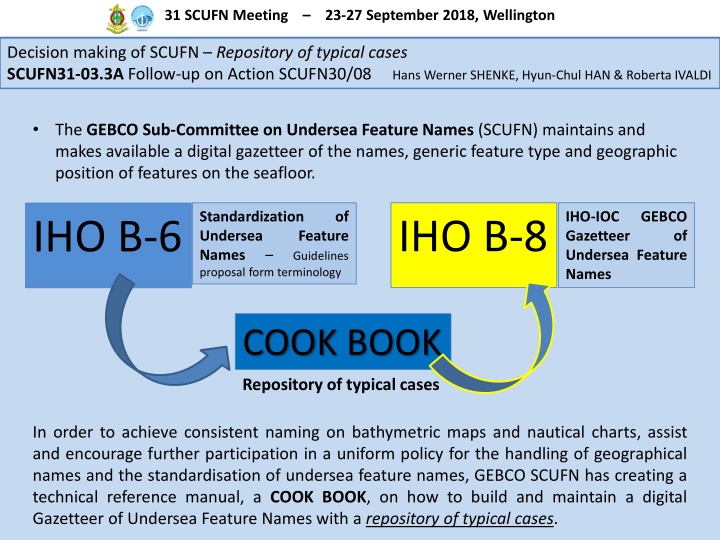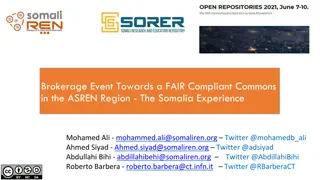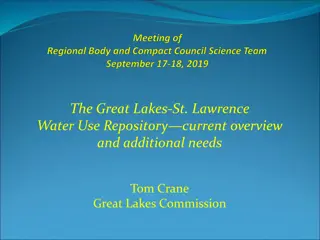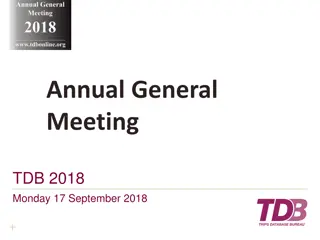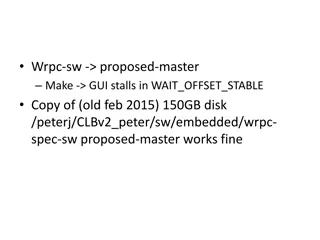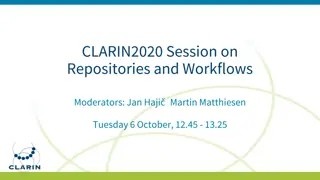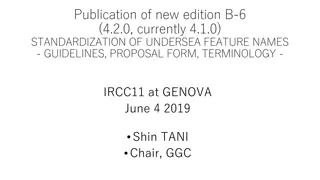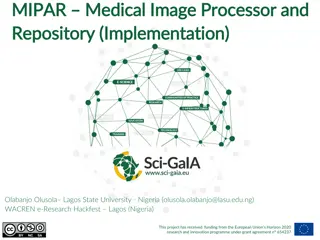SCUFN Repository Decision Making Meeting Summary 2018
SCUFN held a meeting in Wellington in September 2018 to discuss decision making for the repository of typical cases. The meeting focused on creating a technical reference manual to standardize undersea feature names. Various case studies were examined, emphasizing the importance of consistent naming and guidelines. The discussions led to the proposal and preparation of a Repository of Typical Cases to facilitate future decision making processes.
Download Presentation

Please find below an Image/Link to download the presentation.
The content on the website is provided AS IS for your information and personal use only. It may not be sold, licensed, or shared on other websites without obtaining consent from the author.If you encounter any issues during the download, it is possible that the publisher has removed the file from their server.
You are allowed to download the files provided on this website for personal or commercial use, subject to the condition that they are used lawfully. All files are the property of their respective owners.
The content on the website is provided AS IS for your information and personal use only. It may not be sold, licensed, or shared on other websites without obtaining consent from the author.
E N D
Presentation Transcript
31 SCUFN Meeting 23-27 September 2018, Wellington Decision making of SCUFN Repository of typical cases SCUFN31-03.3A Follow-up on Action SCUFN30/08 Hans Werner SHENKE, Hyun-Chul HAN & Roberta IVALDI The GEBCO Sub-Committee on Undersea Feature Names (SCUFN) maintains and makes available a digital gazetteer of the names, generic feature type and geographic position of features on the seafloor. Standardization Undersea Names proposal form terminology of IHO-IOC Gazetteer Undersea Feature Names GEBCO IHO B-8 IHO B-6 Feature Guidelines of COOK BOOK Repository of typical cases In order to achieve consistent naming on bathymetric maps and nautical charts, assist and encourage further participation in a uniform policy for the handling of geographical names and the standardisation of undersea feature names, GEBCO SCUFN has creating a technical reference manual, a COOK BOOK, on how to build and maintain a digital Gazetteer of Undersea Feature Names with a repository of typical cases.
31 SCUFN Meeting 23-27 September 2018, Wellington Decision making of SCUFN Repository of typical cases SCUFN31-03.3A Follow-up on Action SCUFN30/08 Hans Werner SHENKE, Hyun-Chul HAN & Roberta IVALDI The NEED for COOK BOOK is to consider how SCUFN can record razionales supporting decision made for addressing difficult cases in the sessions, so lessons learned can be re- used in consistent manner in the future. As first step we propose and prepare the creation of REPOSITORY OF TYPICAL CASES Generic Term Correct selection of the generic name following the Principles for Naming Features , from the list of definition to reflect physiographic description of features. IHOB-6 Polygon: the number and the position of the points can modify geometries COOK Haka HILL Haka SEAMOUNT ACCEPTED Shinai RIDGE Shinai SEAMOUNT Jianfeng SEAMOUNT BOOK Jianfeng KNOLL IHO B-8
31 SCUFN Meeting 23-27 September 2018, Wellington Decision making of SCUFN Repository of typical cases SCUFN31-03.3A Follow-up on Action SCUFN30/08 Hans Werner SHENKE, Hyun-Chul HAN & Roberta IVALDI Generic Term Correct selection of the generic name following the Principles for Naming Features , from the list of definition to reflect physiographic description of features. IHOB-6 Maps scales and horizontal data resolution: Shoyang Ridge is only an elongate Seamount. Imeungs Seamount, accepted with the generic term changed to Peak, was a very good example of the necessity that have a cookbook to facilitate the analysis (shape and dimensions vary from one feature to another, while remaining compliant with generic definitions in B-6). COOK BOOK Shoyang RIDGE Imeungs SEAMOUNT Shoyang SEAMOUNT Imeungs PEAK IHO B-8 ACCEPTED Yushui SEAMOUNTS Xiazhi SEAMOUNT Gufeng RIDGE Xiongzhi RIDGE Gufeng RIDGE no enough data no distinct feature is a Ridge in a Ridge, incoherent geometry is a Ridge in a Ridge is a Ridge in a Ridge NOT ACCEPTED
31 SCUFN Meeting 23-27 September 2018, Wellington Decision making of SCUFN Repository of typical cases SCUFN31-03.3A Follow-up on Action SCUFN30/08 Hans Werner SHENKE, Hyun-Chul HAN & Roberta IVALDI Imeungs Seamount In B-6 PEAK is defined as A conical or pointed elevation at the summit of a larger feature . However, in the case of accepted Imeungs Peak, it was noted that it was not the highest point of the Babeldaob Ridge. The SCUFN Generic Terms Subgroup needed to allow a definition that can include multiple points within a single feature and to modify the current definition of PEAK in B-6. This SEAMOUNT is located within the proposed Babeldaob RIDGE and it does not fall in the B-6 definition of SEAMOUNT; rather, this SEAMOUNT might fall in the definition of PEAK, A conical or pointed elevation at the summit of a larger feature. However, it appeared that the feature is not really the summit of the proposed Babeldaob RIDGE. In fact, the proposed Ngerbuns Seamount, also located in the proposed Babeldaob RIDGE, is approximately 500 m shallower than Imeungs PEAK . Recommendation: the new definition of PEAK would simply be A conical or pointed elevation on a larger feature such as a SEAMOUNT . In conjunction with this new definition, we also would recommend to re-define PINNACLE as A spire-shaped pillar either isolated or on a larger feature.
31 SCUFN Meeting 23-27 September 2018, Wellington Decision making of SCUFN Repository of typical cases SCUFN31-03.3A Follow-up on Action SCUFN30/08 Hans Werner SHENKE, Hyun-Chul HAN & Roberta IVALDI Specific Term IHOB-6 Correct description of the specific name following the Principles for Naming Features in B-6 1. 2. Short and simple specific terms are preferable. The principal concern in naming is to provide effective, conveniently usable, and appropriate reference; commemoration of persons or ships is a secondary consideration. The first choice of a specific term, where feasible, should be one associated with a geographical feature; e.g.: Aleutian Ridge, Mariana Trench, Katsuura Canyon. Other choices for specific terms can commemorate ships or other vehicles, expeditions or scientific institutes involved in the discovering and/or delineation of the feature, or to honour the memory of famous persons, preferably personalities whose contribution to ocean sciences, exploration or history has been internationally recognized. Where a ship name is used, it should be that of the discovering ship, or if that has been previously used for a similar feature, it should be the name of the ship verifying the feature, e.g.: San Pablo Seamount, Atlantis II Seamounts. Names of living persons will normally not be accepted, in accordance with the recommendation in the UNCSGN Resolution VIII/2. In the rare cases where names of living persons are used (surnames are preferable), they will be limited to those who have made an outstanding or fundamental contribution to ocean sciences. Groups of like features may be named collectively for specific categories of historical persons, mythical features, stars, constellations, fish, birds, animals, etc. For example: Writers, musicians; Descriptive names are acceptable, particularly when they refer to distinguishing characteristics (i.e. Hook Ridge, Horseshoe Seamount). However, this is only advised when a characteristic shape has been established by definitive topographic exploration. Names of well-known or large features that are applied to other features should have the same spelling. A specific term should not be translated from the language of the nation providing the accepted name. 3. 4. 5. 6. 7. 8. 9.
31 SCUFN Meeting 23-27 September 2018, Wellington Decision making of SCUFN Repository of typical cases SCUFN31-03.3A Follow-up on Action SCUFN30/08 Hans Werner SHENKE, Hyun-Chul HAN & Roberta IVALDI Specific Term IHOB-6 Correct description of the specific name following the Principles for Naming Features in B-6 COOK BOOK Zitan Guyot Young Seamount Tell Qarqur Guyot no choice description and connection with ocean; Mr. Young is alive; archaeological site and the name origin is located in a war zone in Syria; IHO B-8 NOT ACCEPTED Ptol m eSeamount Ffynnon Garw Hill ACCEPTED Ptol m e Seamount is accepted with the French written because the French spelling was different to Ptolemy (several features already in the GEBCO Gazetter are named Ptolemy) and would be no confusion; Ffynnon Garw Hill is a very good example of how naming proposal is developed with respect to the specific term. Suggestion for future submission with a frequent name as Young, should be Jimmy Young Smt .
31 SCUFN Meeting 23-27 September 2018, Wellington Decision making of SCUFN Repository of typical cases SCUFN31-03.3A Follow-up on Action SCUFN30/08 Hans Werner SHENKE, Hyun-Chul HAN & Roberta IVALDI Features location IHOB-6 entirely or mainly (more than 50 %) outside the external limits of the territorial sea, not exceeding 12 nautical miles, in agreement with the UNCLOS. Names approved by national authorities in waters beyond the territorial sea should be accepted by other States if the names have been applied in conformance with internationally accepted principles. Names applied within the territorial sea of a State should be recognized by other States. COOK BOOK Area of mutual interest EEZ & SEZ and claimed EEZ & SEZ Haidongqing Seamount, Jinghao Seamount, Tianbao Seamount, Jujiu Seamount and Cuiqiao Hill Recommendation: about the naming proposals that may affect the undersea features located in EEZ and its Extended Continental Shelf, it is well noted that the nominated authority of the country to be consulted by the proposers.
31 SCUFN Meeting 23-27 September 2018, Wellington Decision making of SCUFN Repository of typical cases SCUFN31-03.3A Follow-up on Action SCUFN30/08 Hans Werner SHENKE, Hyun-Chul HAN & Roberta IVALDI COOK BOOK Repository of typical cases The way forward Dec 2018 Subgroup to define the list of content of the repository of typical cases; Feb 2019 Approval by SCUFN Members; June 2019 (Subgroup) List of typical cases as known and template to solve them (title, example, decision made, recommendation); Aug 2019 Approval by SCUFN Members and then submission draft repository to SCUFN32
